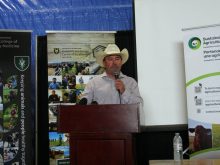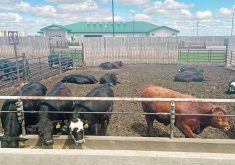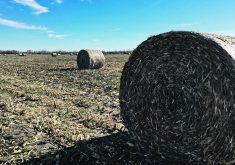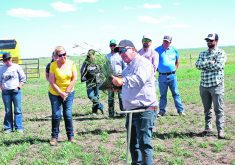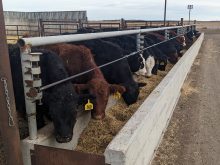Researchers are studying small scales for cattle on pasture and bull neck collars to help producers detect females in heat
Use of smart technologies in beef production is only going to grow. That’s why the Livestock and Forage Centre of Excellence is focusing research on those areas.
Dr. Dinesh Dadarwal, a veterinarian and assistant professor in large animal science at the Western College of Veterinary Medicine, said the LFCE tests technology so producers can make informed choices.
“The biggest area that is going to grow over the next, I would say decade or two, actually, is how you can utilize some of these technologies to fill in for the shortage of labour in the market,” he said.
Read Also

Tick research from the University of Manitoba focuses on insects and testing
Manitoba researchers are looking into the effects of tick and fly disease in cattle.
For example, the LFCE is working on small scales for cattle on pasture. The animals don’t have to be moved to a chute to gather weight data, which is a proxy for feed conversion efficiency.
Moving the animals, weighing them and putting data into a computer is a lot of work.
“What we have been doing, and we actually have done the initial part of establishing it, is we made a weigh scale and put it out into the pasture and made that scale system talk to software,” Dadarwal said.
The scale is on the path toward the water source.
“While it walks over that scale there are sensors on the side. It’s going to read the tag of that animal and the weigh scale will transmit and match up that information,” he said.
The data will automatically update into a management system.
Dadarwal said there are thousands of companies using sensors for various technologies.
“We hope LFCE will become a test and evaluating ground for all of these technologies because some are developed without actually keeping (in) mind, what are the burning issues for producers,” he said. “So, they’re working backwards. We know what the problems are and can focus.”
The veterinary college is also in the business of public service, as opposed to companies that want to make money, he said.
Among the sensor technologies already in the market are those used to detect heat. More commonly used in the dairy sector, they are now being tested more in beef herds.
LFCE is testing one system that uses neck collars containing several sensors on bulls. The females are fitted with ear tags.
“The neck collar can go on to a gomer bull and then as soon as it comes into proximity to a heifer or cow in heat, that’s when it will ping your cellphone,” said Dadarwal.
The producer should then know that it’s time to breed the female.
He said the company claims the product is ready to use but LFCE researchers have found some tweaking needs to be done.
They got some false alarms when, as soon as the collar was put on the bull, it began throwing false positives. That could lead to artificially inseminating females at the wrong time, which won’t work.
Dadarwal said they are comparing this system with more traditional heat detection methods such as stickers.
The older methods indicated the female wasn’t in heat but the neck collar suggested it was.
“The reason we are in this one is because that simple neck collar costs about $3,000 to $5,000, depending on how many animals you want to go for breeding in a particular season. For a producer to spend that much money but the system not working the way it should be, there’s a problem there,” he said.
He said it will be another year before the full findings from the research are available.
Dadarwal also said researchers wonder about the type of data the sensors are generating.
“We think if we have that information we can actually use the same sensor to know which bull was lame, which bull actually bred more cows, which is way more informative than what you get right now,” he said.
For example, in a community pasture situation it would be possible to find out which bull is successfully breeding the females and whether a bull needs to be replaced.
He said the collar must have a GPS sensor because when a bull is put out in a pasture where there is no network, the signal goes to a satellite.
“When a bull mounts a heifer there’s got to be a gyroscope sensor that tells you whether the bull has elevated from the ground or not. And, there’s got to be another proximity sensor because it reads the tag that is on the heifer or the cow that is in heat,” he said. “Those three sensors should be there. There might be a fourth sensor; we don’t know.”
LFCE’s interest in the collars is for all the other information they may be able to provide.
“Breeding is one thing, but can it tell us how many got bred in what duration so we know when those will calve so you can plan ahead of time?” he said. “Another thing is, if the bull is not breeding for the initial three or four days of the breeding cycle, we can tell there’s something wrong with that bull. At the same time, if the bull is lame the gyroscope should pick up the gait of that bull. We are trying to see if we can work with the company to get more information.”
Dadarwal said it would be counterproductive for him as a veterinarian, but if the sensors provide good breeding information then they could eliminate the need for pregnancy checking, especially when a producer doesn’t have a good set-up to do so.
He added that there are more technologies available for females than for bulls and that’s why LFCE is looking at collaborating with companies to see what is possible.
“I can say with confidence that focusing on the bull-only side, we would be the first ones to work on with regards to whether these sensors can tell you more about the bull than the female or not,” he said.
One producer has already indicated interest in testing the technology and that could happen next year.
Dadarwal said another focus area will be what happens if there are two or three bulls with neck collars in a herd and how that complicates things.
Future work will also look at using the pasture weigh scale in a feedlot to identify the animals that aren’t gaining weight or are ill.
Dadarwal said they are working with a camera system that says it can identify animals and complete body condition scoring, but he doesn’t think the system is ready yet.






